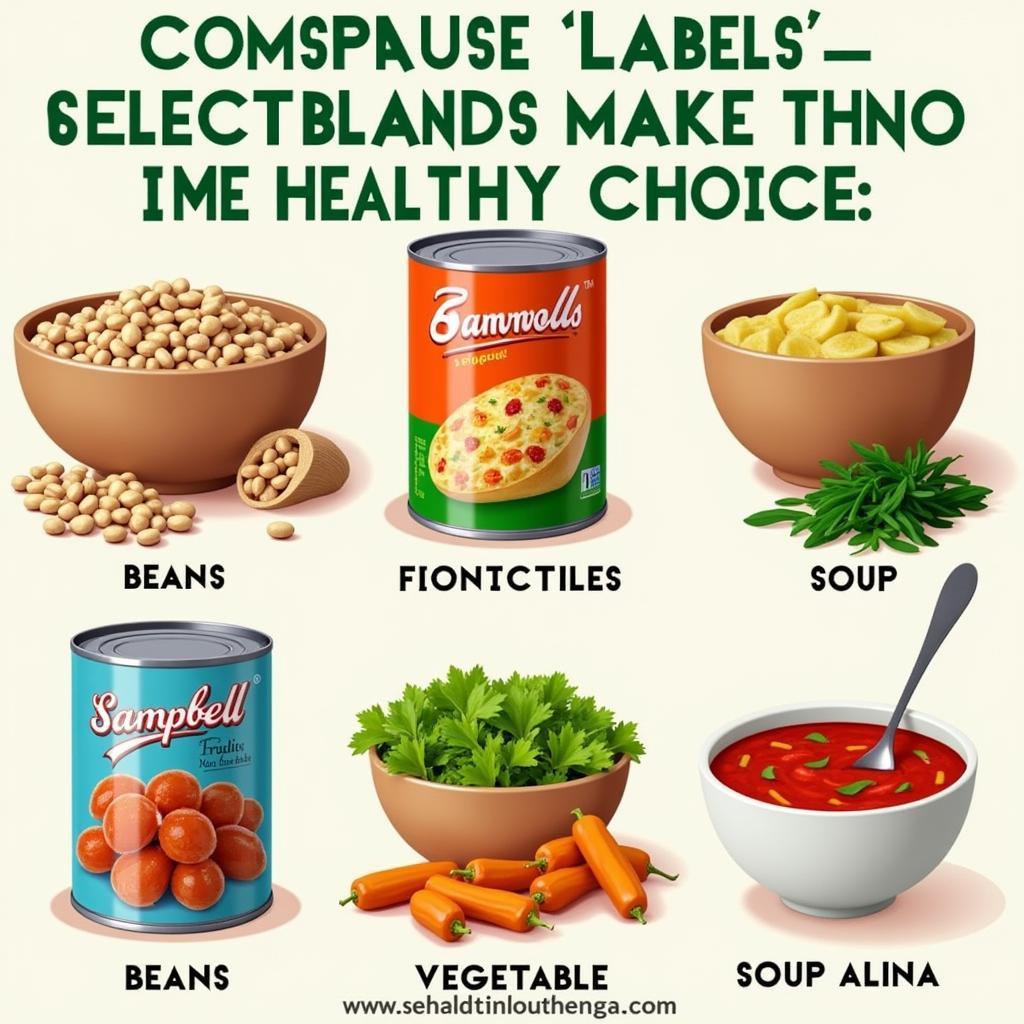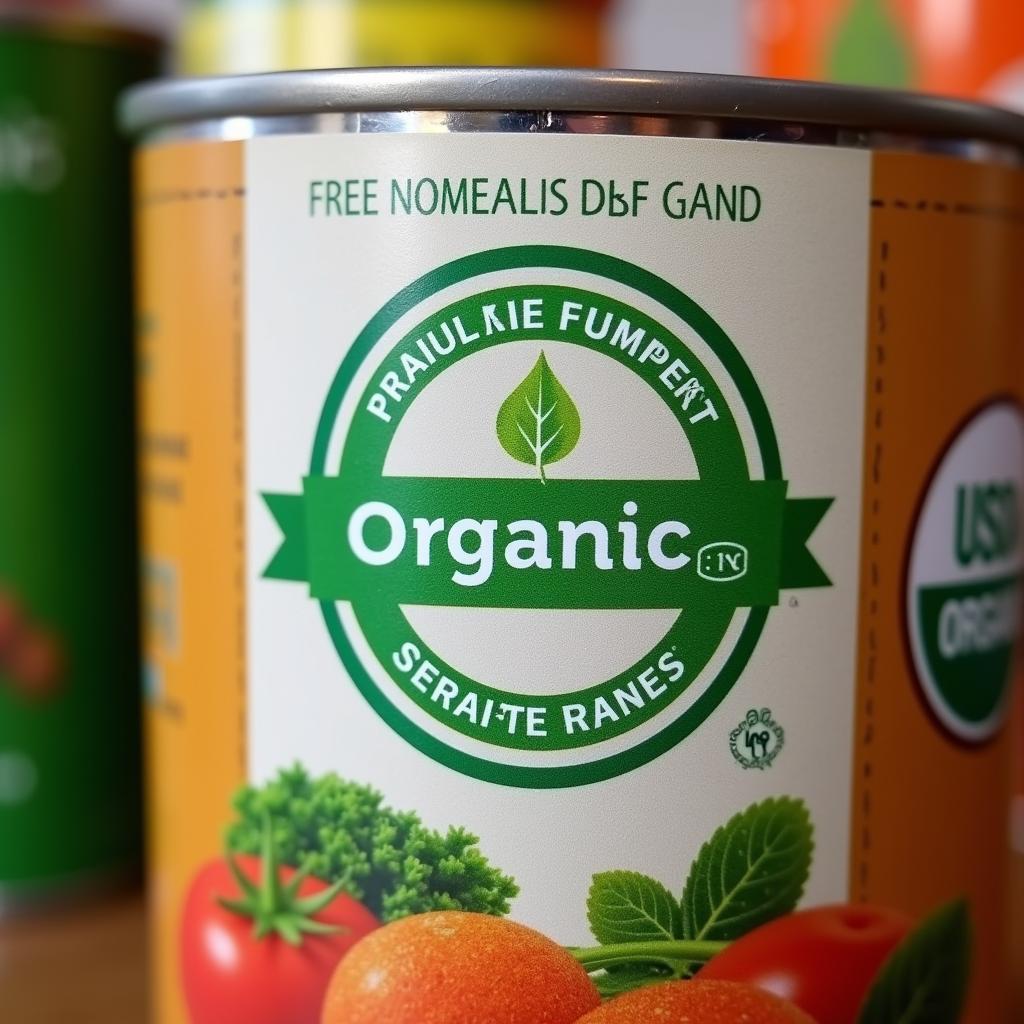Have you ever stood in the grocery aisle, overwhelmed by a sea of Food Can Labels, each promising a healthier, tastier option? You’re not alone! Understanding these labels can feel like deciphering a secret code. But fear not, fellow foodie, this guide will equip you with the knowledge to navigate those labels and make informed choices for you and your family.
Why Bother with Food Can Labels?
In a world of convenient, ready-to-eat meals, canned foods often get a bad rap. However, they can be a valuable addition to a balanced diet. Food can labels are our window into the nutritional value and ingredients of these pantry staples. Learning to read them empowers us to:
- Make healthier choices: Identify hidden sugars, excessive sodium, or unhealthy fats lurking behind those colorful packaging.
- Manage dietary restrictions: Easily spot allergens, gluten, or other ingredients that might not suit your dietary needs.
- Compare products effectively: Find the brand that aligns with your nutritional goals, whether it’s higher protein, lower carbs, or more fiber.
Key Components of a Food Can Label
Let’s break down the essential elements you’ll encounter on most food can labels:
1. Serving Size: The Foundation of Your Calculations
Don’t be fooled by assuming the entire can is one serving! The serving size, usually listed at the top, dictates the basis for all the nutritional information that follows. Always adjust your calculations if you plan to consume more or less than a single serving.
2. Calories: Energy In, Energy Out
This number tells you how much energy the food provides per serving. Keep in mind your daily caloric needs based on your age, activity level, and health goals.
3. % Daily Value: A Quick Nutritional Snapshot
The % Daily Value column indicates how much of a specific nutrient a single serving contributes to your recommended daily intake. A 5% DV or less is considered low, while 20% DV or more is considered high. Use this as a guide to make informed choices about your overall diet.
 Comparing Canned Food Labels
Comparing Canned Food Labels
4. Ingredients List: What’s Really Inside?
This is where things get interesting! Ingredients are listed in descending order by weight. Pay attention to:
- Unfamiliar ingredients: Do some research if you encounter something you don’t recognize.
- Added sugars: These can sneak in under various names like corn syrup, dextrose, or fructose.
- Sodium content: Aim for options with lower sodium, especially if you are watching your blood pressure.
5. Allergen Information: Staying Safe
Most labels clearly indicate common allergens like milk, eggs, peanuts, tree nuts, soy, wheat, fish, and shellfish. Always double-check this section if you have any allergies or sensitivities.
Beyond the Basics: Understanding Claims and Certifications
Food can labels often feature various claims and certifications. It’s important to be a discerning consumer and understand what they truly mean:
- “Organic”: Certified organic foods are produced without the use of synthetic pesticides, herbicides, or fertilizers.
- “Non-GMO”: This indicates the product is not made with genetically modified organisms.
- “BPA-Free Lining”: Look for this claim to ensure the can’s lining is free from bisphenol A (BPA), a chemical that can leach into food.
 Organic Food Can Labels
Organic Food Can Labels
Tips for Navigating Food Can Labels Like a Pro
Here are some expert tips to make you a savvy shopper:
- Read the entire label: Don’t just focus on the front-of-package claims.
- Compare brands: Even similar products can have significant nutritional differences.
- Don’t fear canned produce: Canned fruits and vegetables can be just as nutritious as fresh, especially when they are not packed in heavy syrup or salt.
- Look for low-sodium options: Aim for less than 400mg of sodium per serving.
- Choose cans with BPA-free linings: Prioritize your health and the environment.
Making Informed Choices for a Healthier You
Remember, knowledge is power when it comes to navigating the world of food can labels. By taking the time to understand the information presented to you, you can make choices that align with your health goals and dietary needs. Happy and informed eating!
FAQs
1. Are canned foods less nutritious than fresh?
Not necessarily. While some nutrients can be lost during the canning process, canned foods often retain a similar nutritional profile to their fresh counterparts. They can be a convenient and affordable way to incorporate fruits, vegetables, and legumes into your diet.
2. What does “low sodium” really mean on a food can label?
A “low sodium” product typically contains 140mg or less of sodium per serving.
3. Should I be concerned about BPA in canned foods?
BPA is a chemical that has raised some health concerns. Look for cans labeled as “BPA-free” to minimize your exposure.
4. How can I incorporate canned foods into a healthy diet?
Get creative! Use canned beans in salads, soups, or dips. Add canned vegetables to pasta dishes or stir-fries. Explore different spices and herbs to enhance the flavor of canned proteins like tuna or salmon.
5. Where can I find more information about food labeling regulations?
The Italian food certification website is a great resource for information on labeling standards.
Need More Help?
For personalized dietary advice, consult a registered dietitian or your healthcare provider. They can provide guidance tailored to your individual needs and help you make informed choices about the foods you eat.
Contact us:
- Phone Number: 02437655121
- Email: minacones@gmail.com
- Address: 3PGH+8R9, ĐT70A, thôn Trung, Bắc Từ Liêm, Hà Nội, Việt Nam.
We have a 24/7 customer support team ready to assist you. You might also find helpful information in our other articles, such as this one about where to buy dried food.